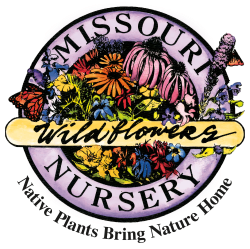Coral honeysuckle, or trumpet honeysuckle, is wonderful vine for hummingbirds. It will grow best in full sun to half shade. East & west sides of buildings are good sites if trees are not producing too much shade. They can climb on shrubs, trees, and other vines along the edges of wooded areas.
Their peak flowering occurs in April and May when hummingbirds arrive, and they can continue to flower sparsely through July. Red fruits may be present July to November. The flowers are pollinated by hummingbirds and visited occasionally by butterflies.
Birds eat the red fruits and use the vines for nesting sites. Coral honeysuckles and other vines produce great escape cover for birds when they are located near feeders. Caterpillars of hummingbird clearwing & snowberry clearwing moths feed on honeysuckle foliage. Whitetail deer, for the most part, leave this species alone.
Coral honeysuckle might reach twenty feet when growing up a tree. They easily grow to the tops of fences, arbors, and pergolas. They climb by wrapping around small diameter objects, like fence wire, other vines, or small woody plants. Rope, grapevines, and cane poles are all suitable for training coral honeysuckle to grow on your chosen structure.
It is native from Oklahoma, Arkansas, Kentucky, and Virginia south to all states bordering the Gulf. It is considered escaped in Missouri & Illinois. Normally, we only offer species that are native to Missouri.
Uses: Hummingbirds, butterflies
Bloom time: April - July
Height: 10 to 15 feet
Space: 4 to 8 feet
Sun: Sun to medium shade
Moisture: Average to moist







